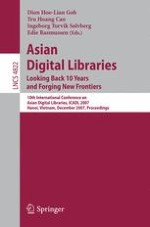The International Conference on Asian Digital Libraries (ICADL) is one of the leading international conferences in digital libraries research. The conference has come a long way since its inception in 1998 as the First Asia Digital Library Workshop held in Hong Kong. Since then, the conference has traveled across the Asian continent and has been hosted by Taiwan (ICADL 1999), Seoul, Korea (ICADL 2000), Bangalore, India (ICADL 2001), Singapore (ICADL 2002), Kuala Lumpur, Malaysia (ICADL 2003), Shanghai, China (ICADL 2004), Bangkok, Thailand (ICADL 2005), and Kyoto, Japan (ICADL 2006). The 2007 edition of the conference marks an important milestone in the ICADL series. Into its tenth year, the conference matured into a significant gathering of practitioners, researchers, educators and policy makers from diverse disciplines sharing a common interest in advancing digital libraries research in Asia. ICADL 2007 was held in Hanoi, Vietnam during December 10–13, 2007, with the theme, “Asian Digital Libraries: Looking Back 10 Years and Forging New Frontiers.” The theme reflects upon the growth of the digital libraries community and explores new areas that the community could delve into in the coming years.
